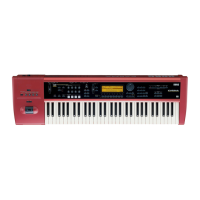45
Basic functions
Program mode
The three elements of sound
Sound can be broken down into three elements: pitch,
tone, and volume.
On this instrument, these elements correspond to the
Pitch, Filter, and Amplifier settings of the program. In
other words you would adjust the Pitch settings to
modify the pitch, the Filter settings to modify the tone,
and the Amplifier settings to modify the volume.
In Oscillator (Oscillator: 2.1: Ed-Basic settings) you
select the waveform multisample that determines the
basic sound, and specify its pitch. This sound is then
modified by the pitch settings (Pitch: 3.1: Ed-Pitch), fil-
ter settings (Filter: 4.1, 4.2: Ed-Filter), and amp settings
(Amplifier: 5.1, 5.2: Ed-Amp) to create the basic sound
of the program.
This basic sound can then be modified further by using
insert effects (7.2: Ed-Insert FX settings), master
effects, and master EQ (7.3: Ed-Master FX settings) to
apply finishing touches. When KARMAfunction set-
tings (6.1 – 6.4: Ed-KARMA) and controller settings
(2.2: Ed-Ctrl) are added to this, the final result is called
a “program.”
Programs that are used in Combination,
Sequencer, or Song Play mode have insert effect,
master effect, master EQ, KARMA function, and
controller settings that are separate from those of
Program mode.
The Compare function
You can press the [COMPARE] to make the LED light.
This will recall the sound that had been written before
you started editing. Press the [COMPARE] key once
again and the LED will go dark, and you will return to
the sound that you had been editing. Use this function
when you wish to compare the unedited sound with
the results of your editing.
When the [COMPARE] key LED is lit, editing a
parameter will make the LED go dark, and that
sound will now be the sound that is recalled when
the [COMPARE] key LED is dark.
Oscillator settings 2.1: Ed–Basic
In 2.1: Ed–Basic you can make oscillator-related set-
tings. This instrument provides two oscillators, and for
each oscillator you can select a basic waveform (“mul-
tisample”) and set the pitch. The multisamples pro-
vided by this instrument include waveforms for
musical instruments such as pianos, as well as special
waveforms unique to synthesizers. Multisamples
reproduce the complex overtone structure and fre-
quency characteristics that allow us to identify a sound
as being “piano-like” or “guitar-like.”
Basic (Prog Basic) page
Mode (Oscillator Mode)
This sets the mode of the oscillator.
Single uses one oscillator and Double uses two oscilla-
tors. In the case of Single the maximum polyphony is
62 notes, and in the case of Double the maximum
polyphony is 31 notes. If you wish to use a Drum Kit to
create a drums program, select Drums. (☞p.46)
Mode (Voice Assign Mode)
Indicates whether the program will sound in Poly
(polyphonically) or Mono (monophonically).
If this is set to Poly, you will be able to play chords
using the program. If this is set to Mono, only one note
will sound even if you play a chord. Normally you will
set this to Poly, but it is effective to use Mono when
you are playing sounds such as analog-synth bass or
synth lead. Try switching between Poly and Mono, and
listen to the result.
OSC1 page, OSC2 page
Specifies the multisample for oscillator 1, 2.
Selecting a multisample
The multisample will determine the basic character of
the program.
● Use “High MS Bank” to select the multisample
bank, and use “High Multisample” to select the
multisample.
If the “High MS Bank” is ROM, you can select pre-
set multisamples. “High Multisample” can be
selected from a range of 000–424. (☞VNL)
If “High MS Bank” is EXB*, you can select multi-
samples from a separately sold EXB-PCM series
option. The type of installed option will be shown in
“*.”
You can use the “Select by Category” utility to
select internal ROM multisamples from 15 catego-
ries. (☞PG p.10)
High Multisample and Low Multisample
If you specify a High and Low multisample for an
oscillator, either the High or the Low multisample will
sound depending on the velocity of the note (i.e., the
strength at which you play the keyboard). This func-
tion is called velocity multisample switching.
1 Specify different multisamples for “High Multi-
sample” and “Low Multisample.”
2 Specify a velocity value for “Velocity SW L→H.”

